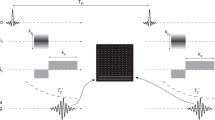Abstract
When an action is applied to a macroscopic substance, there is a particular sort of slow response besides the well-known fast response. Using diffusion theory, the characteristics of slow response in dielectric, elastic, piezoelectric, and pyroelectric relaxation may be explained. A time domain spectroscopy method suitable for slow and fast responses in linear and nonlinear effects is given. Every relaxation mechanism contributes a peak in differential spectroscopy, and its position, height, and line shape show the dynamical properties of the mechanism. The method of frequency domain spectroscopy is suitable only for linear fast response. Time domain spectroscopy is another nonequivalent powerful method. The theory is confirmed by a lot of experimental data.
Similar content being viewed by others
References
Vieira, S., The behavior and calibration of some piezoelectric ceramics used in the STM,IBM J. Res. Develop., 1986, 30(5): 553.
Pillal, P.K.C., A study of absorption currents,European Polymer Journal, 1981, 17: 611.
Kubo, R.,Lectures in Theoretical Physics, New York: Interscience, 1958.
Bottcher, C.J.F., Bordewijk, P.,Theory of Electric Polarization, Vol II, Amsterdam: Elsevier Scientific Publishing Cornpany, 1978.
Li Jingde, Li Jiabao, Fu Shiliuet al., The free and random dielectric relaxations,Acta Physica Sinica (in Chinese), 1992, 41(1): 155.
Delahay, P.,New Instrumental Methods in Electrochemisty. New York: Interscience, 1954.
Li Jingde, The pyroelectric relaxation effect,Acta Physica Sinica (in Chinese), 1984, 33(11): 1563.
Li Jingde, He Di, Long-lasting relaxation effect in piezoelectric ceramics,J. Chinese Silicate Society (in Chinese), 1986. 14 (2): 140.
Williams, G., The use of the dipole correlation function in dielectric relaxation,Chem. Rev., 1972, 72(1): 55.
Haridoss, S., TSC and dielectric response,Physics, 1979, B96: 129.
Li Jingde, Li Jiabao, Fu Shiliu, Application of time domain method in study of FE phase transition,Acta Physica Sinica (in Chinese), 1993, 42(4): 674.
Jiang Zhijie, Fu Desheng, Li Jingde, Slow polarization response of intergranular layer in ceramics,Chinese Science Bulletin (in Chinese), 1994, 39(12): 1081.
Keirstead, W.P., Huberman, B. A., Dynamical singularities in ultradiffusion,Phys. Rev., 1987, A36(11): 5392.
Author information
Authors and Affiliations
Additional information
Project supported by the National Natural Science Foundation of China and the Science Foundation of Zhongshan University.
Rights and permissions
About this article
Cite this article
Li, J., Chen, M., Zheng, F. et al. Diffusion theory of slow responses. Sci. China Ser. A-Math. 40, 290–296 (1997). https://doi.org/10.1007/BF02874522
Received:
Issue Date:
DOI: https://doi.org/10.1007/BF02874522




